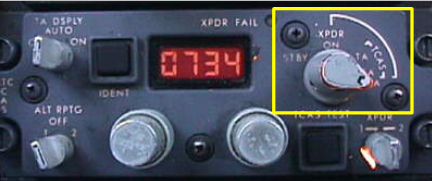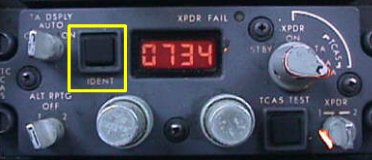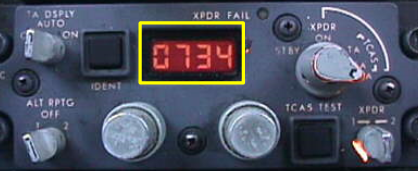¶ Introduction
A transponder (short-for transmitter-responder) is an inboard electronic device that produces a response when it receives a radio-frequency interrogation. It assists ATC (air traffic controllers) in identifying aircraft on a radar scope and other aircraft's collision avoidance systems.
¶ Transponder in real life
¶ Technical description
The ATC radar sends an interrogative 1030 MHz radio frequency pulsed signal. The aircraft answers on the 1090 MHz radio frequency with another pulsed signal. After decoding and measuring the delay of answer, the transmitted signal is used on ATC radar to identify the aircraft (code and/or call sign) and displays relevant information (azimuth, altitude, speed, flight path).
¶ Transponder type
Several different RF (Radio Frequency) communication protocols have been standardized for civilian aviation transponders. Depending on the interrogation mode, transponders can provide identification code, aircraft position, pressure altitude, call sign and other information.
Description of different transponder modes:
- Mode A : equipment transmits an identifying code only,
- Mode C : provides identifying code and aircraft pressure altitude,
- Mode S : (for 'Selective') provides multiple information formats to a selective interrogation (data exchange), including the call sign - it is designed to help avoiding over-interrogation and to allow automatic collision avoidance.
The transponder mode S is the most widely used mode.
¶ Transponder settings
A transponder switch usually has several positions:
- OFF : The "OFF" position will power down the transponder.
- STBY: The "STBY" position will power the transponder and make it ready for operation (warming up).
- ON : The "ON" position (MODE A) will only send primary information to the radar (code and position).
- ALT: The "ALT" position (MODE C or S) will additionally transmit altitude information.
- TA : The "TA" position will provide traffic advisory.
- TA/RA : The "TA/RA" position will provide traffic advisory resolution.


¶ Transponder IDENT
All mode A, C, and S transponders include an IDENT button, which activates a special function known as IDENT (short for identify) in order to help air traffic controllers locate an aircraft.
IDENT should only be pressed on ATC request.

¶ Transponder codes
Transponder transmission usually uses a discrete code in order to identify the flight. Squawk codes are four-digit octal numbers. The dials on a transponder read from 0 to 7 inclusive.
For certain type of flights and/or situations, specific transponder codes are used.
Thus the lowest possible squawk is 0000 and the highest is 7777. Four octal digits can represent up to 4096 different codes, which is why such transponders are often called "4096 code transponders". There is no '8' and no '9' digit in transponder code.

¶ Transponder code allocation
SSR transponder code is normally allocated by each State with coordination with regional air navigation agreements and taking into account overlapping radar coverage over adjacent airspaces.
In IVAO, SSR (Secondary Surveillance Radar) transponder codes can be allocated by divisions through coordination with regional air navigation agreements and taking into account the code allocation practiced in adjacent divisions.
Codes 7700, 7600, 7500 shall be reserved internationally for use by pilots encountering a state of emergency, radio communication failure or unlawful interference, respectively:
- 7700 : Emergency code
- 7600 : Radio failure code
- 7500 : Hi-jack code
Here are the descriptions and the usage of some codes attribution:
¶ Transponder 7700 : emergency
The pilot of an aircraft in a state of emergency shall set the transponder to code 7700 unless ATC has previously directed the pilot to operate the transponder on a specified code.
The pilot shall continue to use the specified code unless otherwise advised by ATC. If the pilot is facing a simple pan or failure, this code shall not be used.
The pilot shall not use the 7700 code outside a state of emergency.
An ATC can request a pilot to squawk 7700 if he declares an emergency or distress situation (MAYDAY).
After the aircraft has landed, an air traffic controller should ask the pilot to set a normal code when the emergency is terminated. As a pilot, set the transponder code to 2000 or ask a new code to the air traffic controller after the emergency is terminated.
¶ Transponder 7600 : radio failure
The pilot of an aircraft losing two-way communication shall set the transponder to code 7600.
On the IVAO network, if a pilot cannot initiate two-way communication by voice with the air traffic controller, pilot and ATC must try to communicate by text as far as possible and pilot does not use squawk 7600.
This code is mainly used when a pilot is facing serious technical problems with his connection that cannot permit voice and text communication or for training/examination purposes.
A controller, who notices a communication failure code, will determine the extent of the failure by instructing SQUAWK IDENT or to change the code. With that operation, if it is determined that the aircraft receiver is functioning, further control of the aircraft will be continued using code changes or IDENT transmission to acknowledge receipt of clearances.
This code shall not be used to ignore ATC clearance and contact.
¶ Transponder 7500 : hi-jacking
In real aviation, if there is unlawful interference with an aircraft in flight, the pilot-in-command shall attempt to set the transponder to code 7500 in order to indicate the situation.
The use of this code is strictly prohibited on the IVAO network. (R&R 6.4.1) "Special operation including simulation of terrorism and act of wars are prohibited. Although armed conflicts do exist in the real world, we do not allow the simulation of any form of aggression or violence on the IVAO network."
As an air traffic controller, if you observe the use of code 7500 or outside your airspace, you should advise the pilot to change his transponder code to a new code immediately as the use of this code is forbidden in IVAO.
If the pilot continues to use this code, please call a supervisor using the .wallop command.
¶ Non-controlled VFR code
Depending on local regulations, non-controlled VFR codes can change.
The most frequently codes used are:
- 1200 : USA and Canada standard squawk code
- 7000 : Europe VFR standard squawk code
- 2000 : ICAO standard squawk code
Other default codes are dependent on whether local regulations have made them available (ex 1400, 3000).
¶ Non-controlled IFR code
There is one unique worldwide code for non-controlled IFR flights which is 2000.
¶ Other codes
This is a list of some other codes available:
- 0000: this code shall not be used. It is a non-discrete code. It is usually displayed on IVAO pilot software in case of some specific technical problems.
- 7777: Non-discrete code used to test transponders and to check correctness of radar stations
- 74xx: these codes are sometimes used for NATO special operations
- ICAO Documentation 4444 - Air Traffic Management - 16th Edition 2016 - Chapter 8.5
- VID 150259 - Creation
- VID 150259 - Wiki integration
- VID 496402 - Wiki.js integration